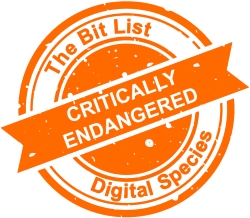Exhibition Content
|
|
 |
|
|
Born-digital or hybrid-digital content that was created and/or commissioned for exhibitions and has not been accessioned into the collection. This species is considered as an object or a 'work' in its own right, and not interpretive materials. |
||
|
Digital Species: Museum and Gallery, Media Art |
Trend in 2024:
|
Consensus Decision |
|
Added to List: 2023 |
New Rescoped Entry |
|
|
Imminence of Action Action is recommended within three years, detailed assessment within one year. |
Significance of Loss The loss of tools, data or services within this group would impact on many people and sectors. |
Effort to Preserve | Inevitability Loss seems likely. By the time tools or techniques have been developed, the material will likely have been lost. |
|
Examples Digital experiences, immersive works, digital artworks, hybrid-digital artworks, media art, and other born-digital or hybrid-digital objects or materials which can take many forms. |
||
|
‘Practically Extinct’ in the Presence of Aggravating Conditions Lack of technical documentation; complex interdependencies related to specific hardware, software and/or operating systems; significant volumes or diversity of data; dependence on proprietary products or formats; lack of preservation capacity in museum or gallery; technology is seen as inherently fragile and therefore risky to collect and preserve; conflation of access with preservation; lifespan of hardware technologies used in legacy works with few/no replacements and/or alternatives; uncertainty over IPR or the presence of orphaned works. |
||
|
‘Endangered’ in the Presence of Good Practice Strong technical documentation; preservation capability; preservation pathway; clarity of intellectual property rights that enable preservation; availability of replacement or alternative hardware technologies. |
||
|
2023 Review This entry was added in 2019 under ‘Digital Materials in Museums and Galleries’ and previously rescoped in 2021 to ‘Supporting Digital Materials for Museums and Galleries’. The 2023 Bit List Council superseded the entry, splitting it into six discrete entries as the scope of the single entry was too broad to provide the guidance needed. The recommendation to break this entry down was also made by the 2021 Jury, as the types of digital collections content in museums can be vast and offer particular risks in museum and gallery contexts. This entry draws attention to risks preserving born-digital or hybrid-digital materials, which can take many forms and may be complex digital objects. These works may be commissioned from an external third-party company, or created by staff internal to an organization, often with a considerable amount of financial investment involved. What is particularly critical is that these materials have not been accessioned into an organization's collection. These objects may inhabit exhibition spaces for many years, and while they may be a key component of an organization's business, have not been (and may not be) ever accessioned into the collection. |
||
|
2024 Interim Review The 2024 Council agreed These risks remain on the same basis as before, with no significant trend towards even greater or reduced risk (‘No change’ to trend). While scores should remain as is currently, a main change to note for 2024 emerging and broader risks that have come even more to the fore for the Museums and Galleries sector, and other Bit List species more broadly: Cybersecurity and ML/AI. Both these have various influences on the sector, and indeed anyone who is managing and preserving digital collections, content and/or data regardless of sector. Political risks are also on the rise globally and this cannot be ignored. For example, from Cybersecurity forum very briefly in the context of discussing the CLOCKSS Threats and Mitigations model. With these in mind, they recommend a full review should be carried out to consider whether broader risks arising with Artificial Intelligence and Machine Learning should be addressed in this section or form a new sub-species (or sub-sub-species), and for considering political risk as an additional category of risk. They also recommend reviewing and scoping for a category of hybrid digital objects that aren't media art (or are found in museums that aren’t art museums) including medical devices, technological developments, etc. |
||
|
Additional Comments Case Studies or Examples:
See also:
|
||





































































































































